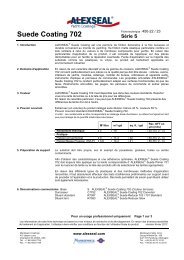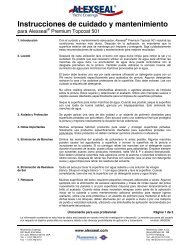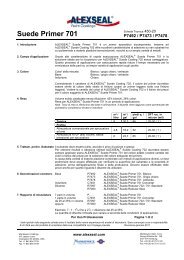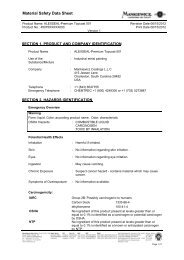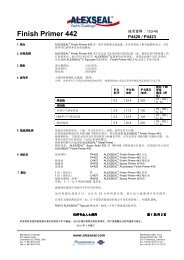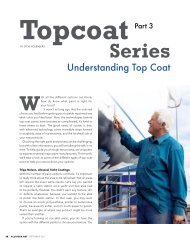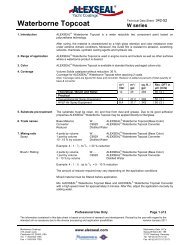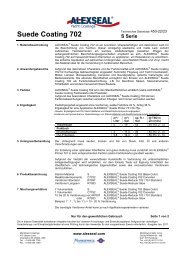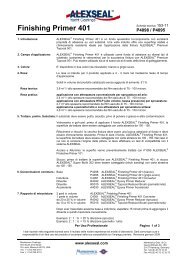Professional Application Guide - Alexseal
Professional Application Guide - Alexseal
Professional Application Guide - Alexseal
You also want an ePaper? Increase the reach of your titles
YUMPU automatically turns print PDFs into web optimized ePapers that Google loves.
Project ConsiderationsDissimilar MetalsWhenever two dissimilar metals are placed in an electrolyte solution, such as sea water,they are prone to galvanic corrosion, also known as electrolysis. Galvanic corrosionis the process in which one metal ionizes or gives up small particles to another metalthat favors it. This process occurs with propellers, rudders, keels, trim tabs and skegsthat are common components of most watercraft. Over time, if not properly protected,these materials corrode with oxidation and pitting, often to the point of mechanicalfailure.Note:If severe electrolysis damage is present, a certified marine surveyor shouldbe consulted and the underlying problem corrected.Important:When assembling or mounting parts together, it is highly recommended touse an insulating material or isolating compounds (such as nylon washers,plastic sleeves or uninterrupted layers of caulk or sealant) between dissimilar metalparts to help prevent electrolysis or galvanic corrosion.ALEXSEAL ® Protective Primers create exceptional barriers to help inhibit galvaniccorrosion. Prior to application of a Protective Primer or other coating, the surface mustbe abraded with special attention paid to removing any remnants of oxidation. On largesurfaces, fairing or surfacing may be required to repair deformities created over time bycorrosion of this type.Note:Surface preparation for an aluminum or copper surface may not be thesame as for steel. Each is susceptible to anodizing to other types of metalsthat it is in contact with – either in the water or by common grounding. Refer to theappropriate section for the type of metal substrate you are working with for instructionson preparation, surfacing and finishing.Project ConsiderationsCuring and Drying of Polyurethane TopcoatsThere are three stages of polyurethane curing:1. When it is dust free2. When it is “tape dry”3. When it is safe to launch the vesselThese stages are referenced with temperature variation within each of “Technical DataSheets” starting on page 64. Pot life, as well as re-coat and overcoat times are alsolisted. Careful attention must be paid to these times to avoid introducing defects intoa surface that could result in the need to resand and/or reapply. To clarify, “Re-coat” iswhen a second coat of the same product may be applied without sanding. “Overcoat”describes when a different product can be applied. Please refer to the appropriate“Technical Data Sheets” starting on page 64 for tape dry times with and withoutaccelerators, and other variables.Tip:Use the “<strong>Application</strong> Record” starting on page 144 to document yourapplication process, equipment settings and environmental conditions forfuture reference. We’d recommend you make photo copies or print copies from theonline resources available at www.alexseal.com.Additional NotesBelow Waterline ConsiderationsALEXSEAL ® epoxy primers, surfacers and fairing compounds may be used below thewaterline prior to the application of an anti-fouling system. When painting the bottom ofa boat it is common to have an overlap area where there are ALEXSEAL ® materials onthe hull sides or bottom, and an anti-fouling system will be applied over the top. Followthe manufacturer’s recommendations for the anti-fouling product to prepare the existingALEXSEAL ® coatings before over coating with another product.Important:It is not recommended to apply polyurethane topcoats below the waterlineor in areas where they will be in constant contact with water. The chemistryof a polyurethane topcoat may allow water to migrate through the topcoat and becometrapped, causing blisters to form in the topcoat.20ALEXSEAL ® <strong>Professional</strong> <strong>Application</strong> <strong>Guide</strong> version 0.4.3ALEXSEAL.COM > Europe: +49 0 40 75 10 30 > North America: +1 843 654 775521




